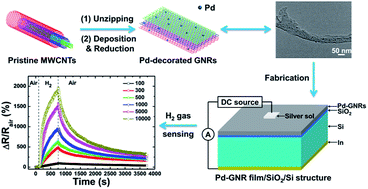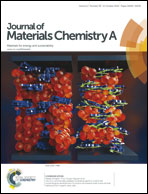Highly enhanced sensitivity of hydrogen sensors using novel palladium-decorated graphene nanoribbon film/SiO2/Si structures†
Abstract
Graphene nanoribbons (GNRs) have been of great interest in a wide range of device applications for their novel physical, electronic and spin transport properties. Here we study the hydrogen (H2) sensing properties of GNRs decorated with palladium (Pd) nanoparticles by a one-step chemical modification and reduction process. A novel Pd-GNR film/SiO2/Si structure was fabricated by transferring a Pd-GNR film onto a heavily doped Si substrate with a native oxide layer. It is demonstrated that the Pd-GNR film/SiO2/Si structure exhibits highly enhanced responses to H2 than the pristine Pd-GNR film at parts-per-million (ppm) concentration levels at room temperature. For example, the Pd-GNR film/SiO2/p-Si structure shows an excellent response (ΔR/Rair) of ∼94% to 100 ppm H2 in air. The sensing mechanism was proposed to explain these H2 sensing characteristics based on p–n junction theory. Our findings demonstrate the incorporation of nanoparticles in GNR-based gas sensors through chemical functionalization and present a novel strategy for the application of GNRs in high performance gas sensors.


 Please wait while we load your content...
Please wait while we load your content...